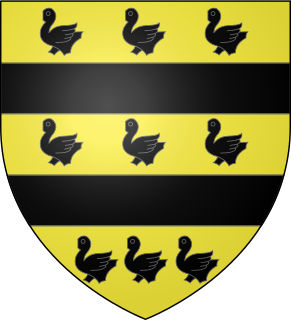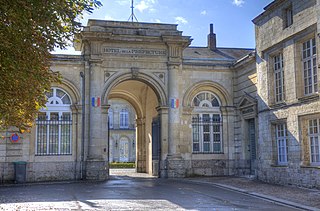Dame Maroie or Maroie de Dregnau de Lille was a trouvère from Arras, in Artois, France. She debates Dame Margot in a jeu parti, or debate song, "Je vous pri, dame Maroie." This song survives in two manuscripts, which each give separate and unrelated melodies. In two manuscripts she is credited with a fragment of a song, "Mout m'abelist quant je voi revenir." Dame Maroie is the addressee in a grand chant by Andrieu Contredit d'Arras. She was identified as the Maroie de Dregnau de Lille from whom a single strophe of a single chanson remains, "Mout m'abelist quant je voi revenir", along with its music.
Gautier de Dargies was a trouvère from Dargies. He was one of the most prolific of the early trouvères; possibly twenty-five of his lyrics survive, twenty-two with accompanying melodies, in sixteen separate chansonniers. He was a major influence on contemporary and later trouvères, and one of the most recorded of medieval vernacular composers. Seventeen chansons courtoises can be assigned indubitably to Gautier, fifteen with music, and three more are probably his, all with music. He imported the Occitan genre of the descort into Old French and left behind three descorts with their melodies. He also participated in two jeux partis, but only one with music. His theme everywhere was courtly love.
Moniot de Paris was a trouvère and probably the same person as the Monniot who wrote the Dit de fortune in 1278. He was once thought to have flourished around 1200, but his dates have been pushed back.
Thomas Herier, Erier, Erriers, or Erars was a Picard trouvère associated with the "Arras school".
Andrieu Contredit d'Arras (c.1200–1248) was a trouvère from Arras and active in the Puy d'Arras. "Contredit" is probably a nickname. He wrote mostly grand chants, but also a pastourelle, a lai, and a jeu-parti with Guillaume li Vinier.
Gaidifer (Gadifer) d'Avion was an Artesian trouvère from Avion. He entered the Church and was associated with the poets of the so-called "School of Arras".
Hue de la Ferté was a French trouvère who wrote three serventois attacking the regency of Blanche of Castile during the minority of Louis IX. He maligns Blanche's partiality to foreigners and singles out Theobald I of Navarre, another trouvère, as unworthy of her support. Hue was a supporter of Pierre de Dreux, Duke of Brittany.
Raoul de Soissons was a French nobleman, Crusader, and trouvère. He was the second son of Raoul le Bon, Count of Soissons, and became the Sire de Coeuvres in 1232. Raoul participated in three Crusades.
Thibaut de Blaison, Blason, or Blazon was a Poitevin nobleman, Crusader, and trouvère from a noble family with lands in Blason and Mirabeau. Eleven poems—one contested and one definitely spurious—have been ascribed to Thibaut in the chansonniers. Three further anonymous songs have also been attributed to him by Terence H. Newcombe, his modern editor.

Guillaume de Ferrières, Vidame de Chartres was a French nobleman, probably the same person as the trouvère whose works are recorded only as by the Vidame de Chartres, his title. Eight songs in total have been attributed to the Vidame, though all but one with conflicting attributions to others. He is not to be confused with Raoul de Ferrières, also a trouvère.
Raoul de Ferrières, originally de Ferier, was a Norman nobleman and trouvère. He was born in Ferrières in what is today the département of Eure. A total of eleven chansons courtoises have been attributed to him.
Guiot de Dijon was a Burgundian trouvère. The seventeen chansons ascribed to him are found in two chansonniers: the Chansonnier du Roi and the less reliable Berne Chansonnier. According to the online edition of the Grove Dictionary of Music and Musicians, Guiot was "technically fluent [and] successfully used a wide variety of poetic structures[, but] is seldom imaginative."
Robert de la Piere was a trouvère of the so-called "school" of Arras. In his time Robert's bourgeois family was prominent in Arras, though the earliest known member is only recorded in 1212. Robert served as a magistrate in 1255, as attested by one surviving document in the municipal archives. There is also a surviving notice of his death in the spring of 1258, at Arras.
Vielart, Vielars, Wilars or Wilart de Corbie was one of the earliest trouvères from northern France. In one instance a chansonnier names him Willame and some scholars have followed this, concluding that "Vielart" and its variations form a sobriquet meaning "violist" or perhaps "old man". He was active in the Île-de-France in the first decades of the thirteenth century at the latest, since his song De chanter me semont Amours was used as the basis for a contrafactum, Quant ces floretes florir voi, by Gautier de Coincy. Only two songs can be firmly ascribed to him, and both survive with musical notation: De chanter and Cil qui me prient de chanter, which served as the basis for a Latin contrafactum, Dic, homo, cur abuteris. Unfortunately the music of the Latin song has not survived. Two other songs are ascribed to Vielart in some sources, but they are more probably the work of Gace Brulé: Desconfortés, plain d’ire et de pesance and Moins ai joie que je ne seuil.
Pierre de Molins or Molaines was an early trouvère. He knew either Gace Brulé or the Chastelain de Couci, two of the first-generation trouvères. He was probably a member of a landed family of Épernay, or possibly of a family resident in and around Noyon. He is probably the local "Pierre II" referred to in documents from between 1210 and 1224.
Colart le Boutellier was a well-connected trouvère from Arras. There are no references to him independent of his own and others' songs, found in the chansonniers. One of these depicts the known coat-of-arms used by the Boutillier family, one of the petty noble clans of Arras, and assigns it to Colart. Another manuscript does not show any arms for Colart and it can be surmised that he was in fact a member of one of the middle-class families of the same name that could then be found in Arras. He may have been a relative of Robert le Boutellier, who judged a jeu parti between Thomas Herier and Gillebert de Berneville.
Richart de Semilli was a trouvère, probably from Paris, which he mentions three times in his extant works. These number ten in one chansonnier, and one anonymous song, "L’une est la chastelaine, devers Mont le Heri", which has sometimes been attributed to him by modern scholars, but of which most of the first strophe and music are missing.
Guillaume le Vinier was a cleric and trouvère, one of the most prolific composers in the genre. He has left compositions in all the major subgenres of trouvère poetry: chansons d'amour, jeux-partis, a lai, a descort, a chanson de mal mariée and a ballade. He wrote Marian songs and even an imaginary dialogue with a nightingale. His work can be dated with some precision: the poem "En tous tens" is quoted in the Roman de la violette, which was written around 1225.

Gautier d'Espinal was a French composer and trouvère poet of the 13th century.
Perrin d'Angicourt was a trouvère associated with the group of poets active in and around Arras. His birthplace was most likely Achicourt, just south of Arras. His surviving oeuvre is large by the standards of the trouvères, and well-distributed in the chansonniers: thirty-five (35) of his songs survive, in some case in as many as eleven different manuscripts.




